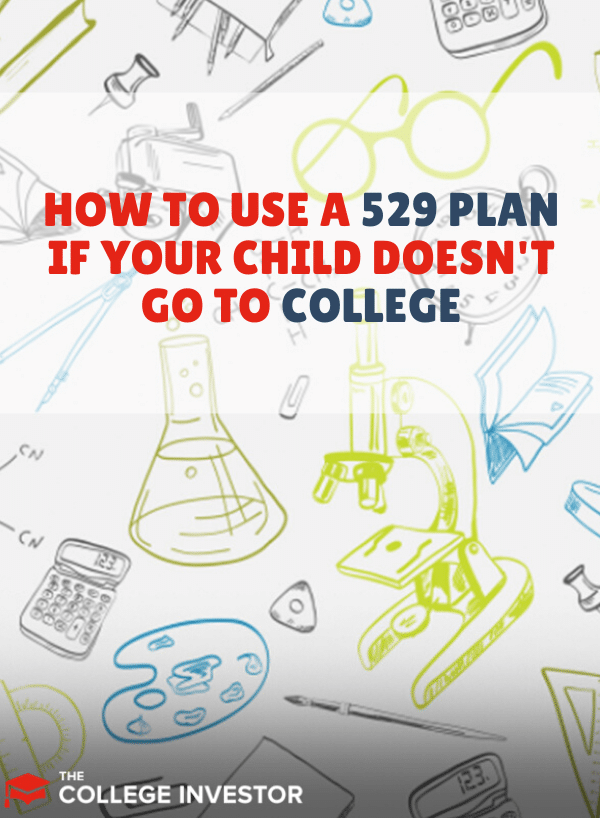
A 529 Plan account is a tax-advantaged savings account designed for higher education expenses. You can put money into the account for a designated beneficiary, and the invested money can grow tax free. As long as you use the money for qualified educational expenses, you’ll never pay taxes on the growth.
However, if you withdraw the money from the account, and you don’t use it for educational expenses, you’ll have to pay a 10% penalty on the earnings and growth. That sounds like bad news for diligent savers who have children who skip college to join the military, the workforce or to start a business.
Thankfully, the money in the 529 Plan account doesn’t have to go to waste. As a parent, there are several ways that you can still put the money in a 529 account to good us, many of which can help you avoid the 529 plan withdrawal penalty. Here are some of your best options.
1. Wait For A Few Years
If you don’t have any immediate plans for the money in your child’s 529 account, wait a few years before taking action. Your child’s may decide to go to college a few years down the line.
It’s traditional for students to enter college within a year or two of graduating from high school, but not everyone takes that path. Some students hope to gain work experience, join the military or grow a business after high school. Focusing on non-school activities for a few years may lead a young person to see the value in higher education.
If you keep the money in the account for your child, you'll avoid the 529 withdrawal penalty today. And you may still get to provide them with an amazing financial head start if they decide to attend school a few years down the road.
2. Help A Family Member Pay For School (Or Eliminate Student Loan Debt)
If you have multiple children, extra money in a 529 account is unlikely to be a problem. You can simply change the beneficiary and help another child pay for their higher education expenses. This is probably the most straightforward way to avoid the 529 plan withdrawal penalty if you have multiple children who are approaching college or graduate school.
If all your other children have graduated from college, you may still be able to help them pay for educational expenses. You can avoid the 529 plan withdrawal penalty if the funds are used to help pay off student loan debt.
The SECURE Act made it possible to use money from 529 accounts to pay off up to $10,000 of student loan debt per beneficiary and each of their siblings. That means an account with $20,000 that won’t be spent could be split between two siblings to pay off $10,000 of student loan debt each.
It's also important to point out that you can switch the beneficiary of your 529 plan to any "qualified family member" without tax consequence. So if your children can’t use the funds, consider transferring them to a niece or nephew, or wait until you have grandchildren and then make them the beneficiary.
Important Note: Not all states are conforming with the rules student loan debt. Find your state in our 529 Plan Guide and check the rules that apply.
3. Use The Money For K-12 Education
If you’ve got children or grand-children who are attending private school, you can avoid the 529 plan withdrawal penalty by using the funds to pay for their education.
Tuition for K-12 private school education is one of the 529 plan qualified education expenses. Just switch the beneficiary to the child who will be using the funds.
Important Note: Not all state are conforming to the federal rules for K-12 education.
Related: How To Use a 529 Plan for Private Elementary And High School
4. Use The Money For Qualified Training Programs
College and private school tuition aren't the only qualified educational expenses. You may also be able to avoid the 529 plan withdrawal penalty by paying for expenses associated with internships or training programs (such as a trade school, certain coding bootcamps, or culinary schools). You'll want to check into the eligibility of these programs before you pass the money on to a beneficiary.
5. Make Yourself The Beneficiary
The money in 529 accounts is meant to be used for educational expenses. If you’re in your 40s, 50s or 60s, you may not see your personal education as a worthy financial goal.
But before you dismiss making yourself the beneficiary, consider the benefits. If you want to switch careers, you could use the money to get a master’s degree, a law degree or some other credential that will make you more marketable.
You can use the funds to take interesting classes from world class professors, even if you aren’t trying to earn a degree. Retirees could use the money go back to school during retirement. Legally, the funds can cover the costs of their studies plus basic living expenses.
Can't Avoid The 529 Plan Withdrawal Penalty? Don't Fret
If you withdraw money from the 529 account, and you don’t use it for qualified educational expenses, you’ll have to pay the 10% withdrawal penalty on the earnings and growth in the account. A 10% penalty sounds like a lot, but the reality is that most of the time it is a very manageable amount.
Consider a family who contributed $1,500 per year to their child’s account for 18 years. Over 18 years, the parents contributed $27,000 to the account. By the time that the child says they do not want to attend college, the account is worth $47,000.
If the parents decide to cash out the account and give all the money to their child, how much will the penalty be? The answer is $2,000 or 10% of the growth. The account grew by $20,000, so the 10% penalty applies to that growth, but not the original $27,000 contributed by the parents.
Note: ordinary income taxes also apply on the earnings (combined with the penalty). And some states have clawback provision to get back any and all tax deductions or credits you may have received.
It is ideal to not forfeit any money in taxes. But the penalty doesn’t seem so bad when you understand that it only applies to the growth in the account and not the entire account. In many cases, your 529 plan performance, even after taking the 10% withdrawal penalty into account, may not be much worse than you'd fare with a taxable brokerage account.
Final Thoughts
Dealing with unused 529 funds may seem like a hassle. But parents have a lot of options to use the funds to benefit themselves or their children. In many cases, you can avoid the 529 plan withdraw penalty. But even if you have to pay it, it's truly not the end of the world.
Consider your options carefully, and don’t be afraid to wait. If you don’t need the money right now, an opportunity to use it may come along in the future. In the meantime, it doesn’t hurt to keep the money growing in the account. And if you're just looking to get started with 529 account savings, here are our favorite brokers to open a 529 plan.

Robert Farrington is America’s Millennial Money Expert® and America’s Student Loan Debt Expert™, and the founder of The College Investor, a personal finance site dedicated to helping millennials escape student loan debt to start investing and building wealth for the future. You can learn more about him on the About Page or on his personal site RobertFarrington.com.
He regularly writes about investing, student loan debt, and general personal finance topics geared toward anyone wanting to earn more, get out of debt, and start building wealth for the future.
He has been quoted in major publications, including the New York Times, Wall Street Journal, Washington Post, ABC, NBC, Today, and more. He is also a regular contributor to Forbes.
